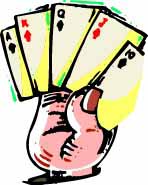Monte Carlo Technique
Return to
Marketing and Promotion page
You should review Breakeven Analysis
before this section.
While breakeven analysis is a 'must know' for business owners, Monte
Carlo Technique is something most business owners never use. I have
included it because it is really very simple, and it is another decision
making tool that you should know.
Monte Carlo Technique looks at risk. Every business decision carries
risk (even not making a decision carries a risk). In Monte Carlo
Technique you simply assign an estimated probability to various outcomes
to estimate the most likely outcome of a decision and to evaluate your
risk.
In Breakeven Analysis we looked at
this simple example:
You want to start offering your customers a finishing service to
make custom needlework pillows. You estimate that it will cost you
$500 for a sewing machine and other equipment, plus $100 for models
to show different styles of finishing. You estimate that on average
you would make $15 profit on each pillow (after labor and
materials).
Breakeven analysis tells us that the breakeven point is found by
dividing $600 by $15 = 40 pillows. But this doe not tell us what the
expected profit (or loss) is.
Remembering high school algebra, we can express our first year profit
as:
(#of pillows) x $15 less $600 investment = profit
The simplest way to estimate profit is to simply take your best guess
of sales and plug it into the formula. For example, if your best guess
is that you will sell 50 pillows the first year. The estimated profit
is:
(50 pillows) x $15 less $600 investment = $150 profit
(year 1)
Naturally, after the first year the equipment is paid
for, so your profit in futures years would be higher.
And for most decisions, this is a pretty good way to make an
estimate. You know that your maximum loss is $600 (no pillows sold).
Your breakeven is 40 pillows sold. Your estimated profit is $150 for the
first year.
Monte Carlo Technique simply takes you one step further.
Suppose you estimate the chances of selling 20 pillows is 20%,
selling 40 pillows is 30%, selling 60 pillows is 30%, selling 80 pillows
is 15%, and selling 100 pillows is 5%. (the percentages always add to
100%)
The estimated profit is the total of the following:
[(20 pillows) x $15 - 600] x .2 = -60
[(40 pillows) x $15 - 600] x .3 = 0
[(60 pillows) x $15 - 600] x .3 = 90
[(80 pillows) x $15 - 600] x .15 = 90
[(100 pillows) x $15 - 600] x .05 = 45
The estimated profit is the total: -60+0+90+90+45
= $165
The result was not much different (and probably just as accurate) as
our original guess of $150 profit. So why go to the extra work?
Monte Carlo Technique gives you an idea of the risk of a decision. In
this example, there is a 20% change you will loose $60. There is 50%
change (20%+30%) that you will not make a profit in the first year.
This type of detailed estimate becomes important for large
investments. Suppose the investment was $60,000, instead of $600. Could
you afford the 50% risk of not making a profit the first year?
A spreadsheet
makes the calculations easy to do. If you have not used a spreadsheet, I
encourage you to take the time and learn.
|


 Visit Yarn Tree's
Facebook &
Instagram
for new products and news.
Visit Yarn Tree's
Facebook &
Instagram
for new products and news.